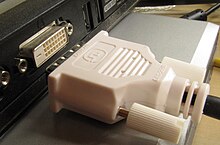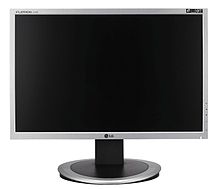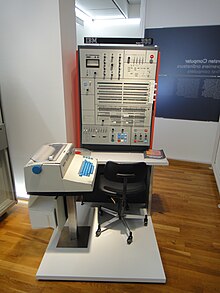Computer monitor
A computer monitor is a screen that is primarily intended to be connected to a computer . In the years between 1985 and 2005 in particular, televisions and computer monitors developed very far apart (quality, frame rates, signals, levels, connectors); since 2010 these have been growing together again.
history
Output devices of the early days
In the early days of computers, there were no computer monitors, or computer keyboards and mice. Input and output took place via punched cards (stacks) or punched strips. This was created with punch card punches (or tape punches ). Finally, printers (actually teleprinters ) were responsible for outputting the data that were stored on the punched cards or strips, or rather that were calculated from this data (list output).
From the beginning of the 1960s, mainframe systems such as the IBM S / 360 series came onto the market, which could be operated with the help of text commands on a keyboard, with the output data being visualized on endless paper with the help of an impact printer. Since only the binary control codes for the characters to be printed had to be transmitted for printing, this method, in contrast to the digital modulation of image data, could already be implemented before the invention of the monitor. The first computer terminals were designed in such a way that they could interpret the same control data as a printer of that time in order to generate text output on the screen.
Computer terminals
In the early 1970s, computer terminals began to appear. Typical representatives were e.g. B. the IBM-3270 -Terminals or VT100 -Terminals, which ANSI.SYS reminds of under MSDOS. The detour via punched cards and tapes disappeared, with the help of such terminals it was possible to communicate directly with a computer. The characteristic feature was that communication still had certain similarities with teletype machines and punched tapes. They were mostly controlled serially with text and control characters, similar to teleprinters. Entries were collected and transmitted to the central computer (with its precious computing time).
The monitors themselves were mostly white, green or orange monochrome monitors based on cathode ray tubes (CRTs) such as televisions. The terminals usually had 80 or 132 characters per line with 24 or 43 lines. The resolution was between 240 and 350 lines, frame rates at 50 or 60 Hz, often with luminescent phosphor to minimize the flickering caused by the picture grid structure.
Emerging home computers, beginnings of the personal computer
For home computers, existing technology was used - the home television. Special computer monitors were somewhat better. The display quality also depends on the interface used between computer and television; in ascending order:
- Control via an HF modulator . A maximum of 40 characters per line is usual.
- Control by FBAS signal via a video input, which u. a. was also intended for video recorders.
- Control by means of separate color and brightness signals ( S-Video ).
- Control by means of RGB signal (mostly via SCART).
The further down the list the process is, the less - of the signal processing stages that are actually only necessary for television transmission via antenna - are involved in the transmission; accordingly, the respective inherent limitation of the signal quality eliminates bandwidth limitation or modulation s artefacts . However, at the beginning of the home computer era, an input other than the one for the RF signal (antenna input) was not a matter of course on the existing television, which is why practically every television is suitable for output via the RF modulator. On the other hand, the picture signal of many home computers is not based on an RGB signal at all; they generate a FBAS or S-Video signal directly, which is why an RGB monitor cannot be used there.
The advent of high resolution computer monitors
There were computer monitors for home computers like the C64 as well as for office computers like the IBM PCs. During the following decades, the display standards in IT technology continued to develop, while there was practically no progress due to the existing standards of television transmission (apart from detailed improvements). As a result, computer monitors and televisions diverged extremely over the course of almost 20 years. With the first step away from the TV-compatible home computer, displaying a computer image on a TV was practically impossible. However, the advances in digital technology later made it relatively easy to convert standards to a high quality. On the one hand, this enables television signals to be generated from computer image data; on the other hand, this was a prerequisite for the further development of television standards while maintaining downward and upward compatibility , which brings computer and television technology closer together again.
Flat screens
Around the year 2000, flat screens appeared in both the computer and television sectors . Plasma screens were initially used in televisions, and liquid crystal screens (LCDs) with thin film transistors (TFT) in computer monitors .
High-resolution flat screens in monitors must be able to display a very large number of picture elements ( pixels ) both horizontally and vertically. The original liquid crystal displays (LCDs) with passive matrix control were not suitable for this. The combination of thin-film transistors with each pixel of an LCD brought the technological breakthrough to realize displays with a high information content with such active matrix displays . Active matrix monitors with OLEDs instead of LCDs have also been available since around 2015 .
With DVI for computers and HDMI for televisions, very similar standards for controlling binary displays have been developed.
connections
TV and home computers
In the field of home computers, the connection technologies for carrier frequency signals (via HF modulator ), video and RGB signals (e.g. Belling-Lee connectors , BNC , cinch , DIN or SCART connector).
Monitors


The transmission of video signals changed several times.
- Era 1: Video signals were transmitted in the same way as with television sets. Any number of colors could be transferred. Synchronization is transmitted with the brightness channel or with the green channel.
- Era 2: The IBM PC favored digital transmission with separate transmission of the synchronous signals.
- Monochrome monitors were controlled by two signals (video, intensity) and two synchronous signals (HSync + and VSync−)
- Color Graphics Adapter monitors via four signals (Red, Green, Blue, Intensity) and two synchronous signals (HSync + and VSync−)
- Enhanced graphics array monitors via six signals (Red, Green, Blue, Red-Intensity, Green-Intensity, Blue-Intensity) and two sync signals (HSync + and VSync−)
- Era 3: With the Video Graphics Array, IBM once again only used one line per color (red, green, blue) over which the intensity was transmitted in analog form. Up to 2 18 colors were supported. The two sync signals were retained.
- Era 4: Digital transmission of analog signals as digital data via 1 or 2 lines. Synchronization signals as special code words in the digital data stream.
- Era 5: In Era 4, the signal is transmitted with the exact timing from Era 3. This habit is also broken and video data is transmitted as asynchronous packets.
Sync signals
Computer monitors usually require separately transmitted sync signals (HSYNC + VSYNC). Both signals are rarely transmitted together (CSYNC). Transmission with the brightness signal (YUV) or Sync-on-Green, the standard for video, is not used.
Digital visual interface
Digital Visual Interface (DVI) is an interface for the transmission of video data. In the PC sector, DVI developed into a standard for connecting TFT monitors to the graphics card of a computer. DVI includes the simultaneous output of analog (DVI-A or DVI-I) and digital video signals (DVI-D and DVI-I). DVI is largely compatible with the later HDMI.
High definition multimedia interface
High Definition Multimedia Interface (HDMI) is an interface developed from mid-2003 for the fully digital transmission of audio and video data in entertainment electronics. It standardizes existing processes, increases the quality features compared to them, and also offers a coherent copy protection concept (DRM).
DisplayPort
DisplayPort (DP) is a universal and license-free connection standard standardized by the VESA for the transmission of image and sound signals. Main areas of application are the connection of monitors and televisions to computers and similar devices.
Quo vadis
The path is clearly mapped out towards a general interface that is capable of both power supply and data transmission as well as the output of video data. See USB 3.1 with Type C connector , Mobile High-Definition Link (MHL) and Thunderbolt .
Analog TV
Serial digital interface
The Serial Digital Interface (SDI) is a serial digital interface, primarily for the transmission of uncompressed and unencrypted video data via coaxial cables or optical fibers. It is mainly used in the field of professional television studios and television broadcasters.
The SDI interface is specified by the Society of Motion Picture and Television Engineers (SMPTE) and represents a further development of the analog video standards such as the PAL or NTSC method.
Technical types according to the type of image display method
Raster displays vs. Cathode ray tube (CRT) vector displays
Grid displays cover the entire screen in a fixed grid. The electron beam is scanned light or dark depending on the representation.
Vector screens work much like a plotter. Surfaces can be displayed poorly, but lines are very good. From a certain complexity of the representation, the picture flickers increasingly because the drawing takes too long and the picture can be written less than 40 times per second.
Flat screens
While newer LCD computer monitors and HDTV monitors all have square pixels, old LCD computer monitors and SDTV screens have both square and non-square pixels. Non-square pixels were common on early CGA and EGA laptop displays. SDTV monitors were often based on the ITU-R BT.601 and had 352, 704 or 720 pixels horizontally. Neither with 4: 3 nor with 16: 9 nor with PAL nor with NTSC the pixels were then square.
Data transfer
The connection to the TFT monitor is not only a question of compatibility, but also of the quality of the image. DVI is a digital interface for graphics cards and monitors (Digital Visual Interface). VGA is the analog interface (Video Graphics Array). The graphics data are processed digitally in the PC, which are then converted into analog signals in the graphics card.
A TFT monitor requires digital signals to display the images. If a TFT monitor is now operated via a VGA connection, an analog-digital converter in the monitor must convert the analog signal into a digital signal. As a result of the conversion, the quality of the image is more or less attenuated, depending on the components used. Slight blurring and flickering can be the result. The best combination is a graphics card with digital DVI output and a monitor with DVI input. Using a DVI-VGA adapter, a TFT monitor that only has a VGA connection can be operated on a graphics card with a DVI connection, but with this method the image is still transmitted in analog format.
Modern computer screens darken after a certain time from unchanged data signals or go into stand-by mode to save electricity . ( See also: Green IT )
Standard resolutions
There are both graphic standards and typical resolutions for graphic modes , most of which are standardized via the VESA.
The screens are factory-set to a gamma of 2.2 and a color temperature of 6500 K. These values (if they can be displayed) can be adjusted using color management software.
Flat screens, like tube screens with cathode ray tubes, have a maximum and minimum display resolution. While with a tube monitor no resolution fits exactly over the native shadow mask and therefore all resolutions are displayed correspondingly blurred. Most other resolutions have to be interpolated and therefore appear less sharp. Exceptions are resolutions that divide the maximum resolution in terms of height and width and therefore do not require interpolation of intermediate pixels, such as half or a quarter of the native resolution. The native resolution is specified in the type description of the monitor.
The native (= maximum) screen resolution of the flat screen monitor used is therefore particularly recommended as the desktop screen resolution of the operating system today. Modern operating systems take over the scaling of the screen display in the desired display size and enable the graphics card to control the flat screen in its native resolution.
Screen dimensions
The exact screen diagonal is given for TFT monitors. For earlier CRT monitors the (not fully usable) diagonal of the glass bulb was specified. This diagonal was about 2.5 to 4 cm larger than the really usable diagonal.
The aspect ratio of tube monitors was almost (?) Without exception 4: 3. In the beginning, this was also the case with flat displays. 17-inch and 19-inch devices were mostly available with a resolution of 1280 × 1024 and an aspect ratio of 5: 4. With the advent of 24-inch devices around the turn of the millennium, 16:10 and, since 2008, 16: 9 devices were added. The latter now have a market share of around 90 percent.
Another parameter for tube devices was the maximum line frequency or the maximum image frequency for a given resolution. Since the TFT era, this has become less important and is usually 60 Hz. Flickering no longer has anything to do with the refresh rate of the image content.
Well-known manufacturer of computer monitors
See also
Individual evidence
- ^ Anatomy of a Video Signal - National Instruments. Retrieved February 7, 2019 .





